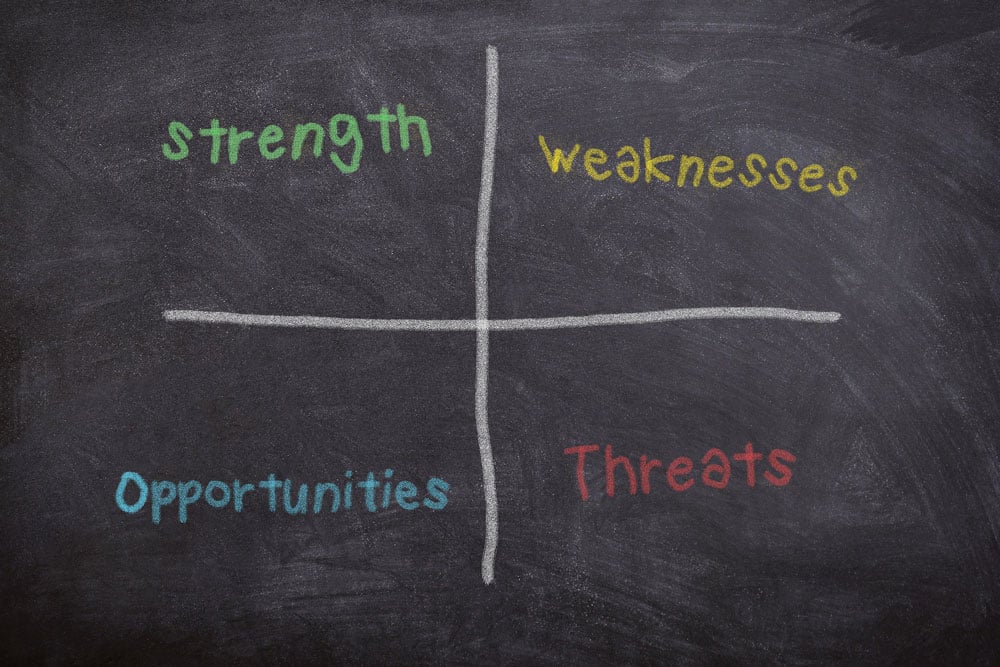Table of Contents
SWOT analysis is probably the most common and best-known market analysis tool used by businesses to decide on their internal and external strategy. It is still highly relevant today; all too frequently we concentrate on superfluous elements that distract us from first answering the basic questions ‘who are we?’ and ‘where do we want to get to?’
Before we explain the various elements of SWOT analysis in detail, let’s first introduce its origins and why it became so popular.
What is SWOT analysis? SWOT analysis is a planning method used in the marketing world that helps businesses to analyse the current situation and take reasoned decisions, taking into account all the factors that could influence their goals. Specifically, SWOT analysis is used to highlight the Strengths and Weaknesses of a business or specific project, and to demonstrate the Opportunities and Threats presented by the external environment. The name SWOT is an acronym of these four elements.
SWOT analysis is important because it allows businesses to assess the context of their work and therefore how to act, based on brainstorming and analysis. First of all, a period of internal reflection at a business helps to clarify its potential and its main advantages in a particular market segment. Doing the same analysis for its competitors and the factors that could influence its development enables it to choose its strategy with greater awareness, and so reduce risk and prepare itself for potential unforeseen events. SWOT analysis also provides a set of guidelines to ensure managers, employees, colleagues and suppliers are on the same wavelength and working with the same goals in mind. However, it should not be seen as a static tool; the analysis should be reassessed several times throughout the year to reconsider the various factors, making some adjustments if necessary.

How SWOT analysis is structured
As we have seen above, SWOT analysis consists of four factors that together make up a square matrix that is filled in during the research. These are grouped into two categories:
- endogenous factors (strengths and weaknesses);
- exogenous factors (threats and opportunities).
Endogenous factors
Strengths and weaknesses are known as endogenous factors because they are integral elements of the business system itself and can be acted upon directly by the company.
The strengths should highlight the business’ intrinsic qualities that enable it to achieve its targets and that differentiate it from its competitors. These can be tangible or intangible, and may include human resources, a solid financial position, loyal customers, a well-positioned brand, cutting-edge technology, special relationships with suppliers or a favourable geographical location. Crucially, these strengths must be points of difference: characteristics unique to the business, which can be determined by examining the insights obtained from analysing your competitors. For example, if all your competitors also provide high-quality products, this cannot be considered a strength in your market, as it is necessary simply to compete.
On the other side of the matrix are the weaknesses, the characteristics that place the business in a disadvantageous position compared to the competition. To find them, you need to carry out an honest, and above all realistic, internal analysis: it is impossible to excel at everything, but you need a clear idea of where you can improve and what your shortcomings are. Items listed here may include a weak brand, a lack of investment capital, poor customer loyalty, obsolete technology or significant debts – in other words the opposites of the potential strengths.
However, both the strengths and weaknesses have one thing in common: they can be controlled. The business can come up with strategies and objectives to make the most of its strengths and intervene directly on its weaknesses.
Exogenous factors
The second part of a SWOT analysis involves opportunities and threats, or exogenous factors: the variables that influence the business but which the organisation has no direct control over.
Let’s look first at the opportunities: any events in the external environment that can be used to develop the business or obtain a competitive advantage. Businesses should always be aware of the situation around them and any trends that are developing, so they are ready to reap the benefits. A market opportunity is a need or interest revealed either directly or indirectly by customers that the company can respond to and profit from. There tend to be three sources of market opportunities:
- offering something that is in short supply where there is clear demand;
- providing an existing product in an innovative way;
- offering a new product or service.
To seize and actively influence opportunities arising from the external environment, you need to ask which strengths you can exploit and which weaknesses need to be tackled or overcome. External variables tend to involve social, economic or cultural changes, new government policy, technological innovation or changes to competitors.
Conversely, the threats are any trends that may prevent a business from reaching its objectives, or which could even damage the firm. Examples could include an increase in the cost of raw materials, increasingly aggressive competition or even a weather event that slows down deliveries. It is vital to be able to pre-empt threats or at least be prepared to tackle them, so you can respond quickly when they arise.
That said, identifying these opportunities and threats is not always particularly simple. This is where an additional analysis tool known as PESTLE (Political, Economical, Social, Technological, Legal and Environmental) may come in handy: it provides a structured way to study exogenous factors and the areas that could influence the business from the outside.
When to use SWOT analysis and the potential results
One of the reasons SWOT analysis remains relevant today is that it can be applied to many different situations. For example, it may be useful to define your company’s mission and vision, to promote growth at your organisation by looking at where you are and where you want to go, to improve your financial stability or to promote innovation and new ideas. You can also apply SWOT analysis to solve specific problems such as managing financial resources, enhancing your business culture, developing new products, improving the structure of the business or launching an advertising campaign.
Once you have worked out when you want to apply it, you need to aim to turn weaknesses into strengths and threats into opportunities. SWOT allows marketing teams to bring together various points and gain a better understanding of where to invest and what decisions to take next. This operation should result in increased value for customers and an improved competitive advantage, but the main aim of SWOT analysis in marketing is to create further advantages so you can reach new customers, retain existing ones and improve customer lifetime value. If carried out successfully, SWOT can increase your return on investment (ROI).

SWOT analysis: the process in detail
The first step when beginning a SWOT analysis is to form a work team. It is absolutely essential to identify the goal you are striving for, so that all members of the group are clear on the aims and feel involved in the final decision: only then will everyone be able to make a meaningful contribution to the process. You also need a moderator, someone who can stimulate debate and enable different viewpoints and ideas to emerge.
Once these things have been sorted out, you can begin the brainstorming stage, focusing specifically on each part of the SWOT analysis.
But how exactly do you conduct a SWOT analysis? The following questions may help you to reflect and lead the conversation at its various stages:
Strengths
- What are our business’ unique advantages? What is our USP?
- What do we do best? And what do we do better than our competitors?
- What unique resources do we have?
- Why do customers choose us and not another company?
Weaknesses
- Which factors could we improve?
- Why do customers move away from the business?
- What do our competitors do better than us?
- What should we avoid focusing our efforts on?
Opportunities
- What opportunities have arisen in the past? And what awaits us in the future?
- Are we aware of any emerging trends? Could we test some of them?
- Where can we expand or invest?
- Who could we partner with?
Threats
- Are technological changes undermining our positioning?
- What are our competitors doing?
- How is demand evolving?
Once you have come up with your ideas, you need to clarify them one at a time to remove any doubts. Next, take the elements agreed upon by the whole work team and summarise them in the SWOT matrix. Finally, it is worth cross-checking all the factors identified, to optimise results and reduce the risks. For this, you can use an evolved version of SWOT analysis, the TOWS matrix, a diagram that goes through the various fields to ensure you have considered all possible options. For example, you will look at exploiting your strengths to generate opportunities and monitoring your company’s weaknesses to avoid possible risks. If used correctly, TOWS gives you a full awareness of both the external and internal environment and allows you to exploit them to expand the strategic options you have available.

Mistakes to avoid during SWOT analysis
Identifying all the different variables in SWOT analysis may seem simple, but a period of corporate catharsis and time spent observing trends is required to achieve the best results. There are various pitfalls to avoid and precise rules to follow to avoid losing your way:
- Be realistic and honest when defining your strengths and weaknesses;
- Strengths should always be analysed from the point of view of customers, suppliers, employees and stakeholders;
- Be as specific as possible to avoid grey areas that may cause confusion;
- Always complete the various fields in relation to your competition and the context surrounding the business;
- Repeat the SWOT analysis at regular intervals, since the internal and external environment is constantly evolving;
- Don’t be tempted to want to turn every weakness into a strength: you can’t be brilliant at everything, and you need to optimise your investments;
- Summarising the ideas that arise from the brainstorming is crucial to ensure clarity and avoid your SWOT analysis being full of endless lists.
Well-organised and well-directed SWOT analysis can reap huge rewards for a business. That’s why this matrix is still widely used today and continues to help companies make informed decisions.



